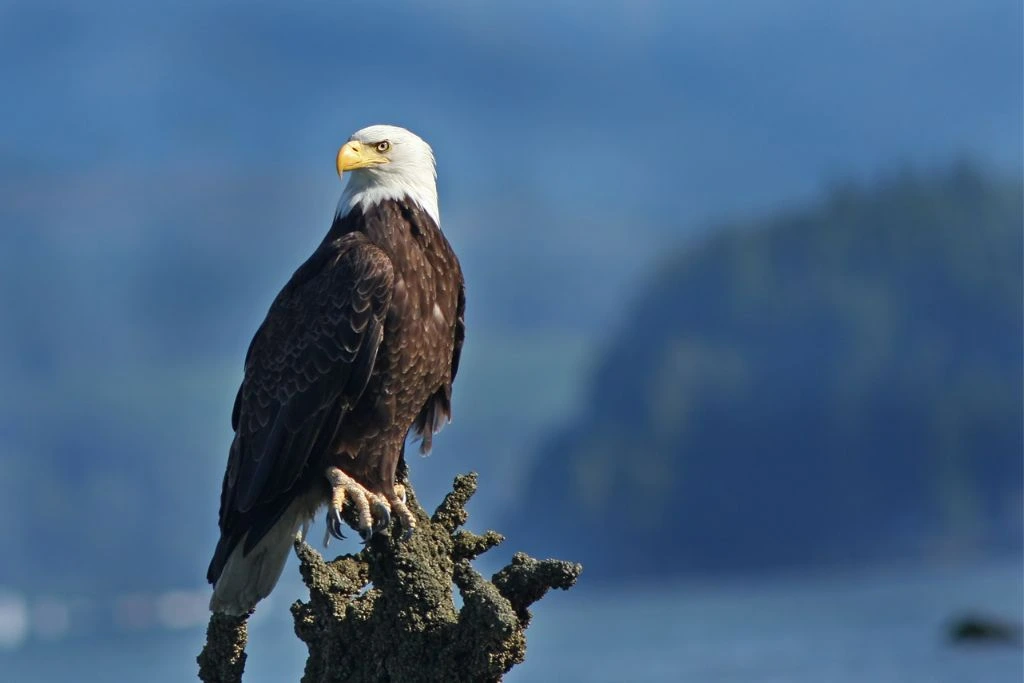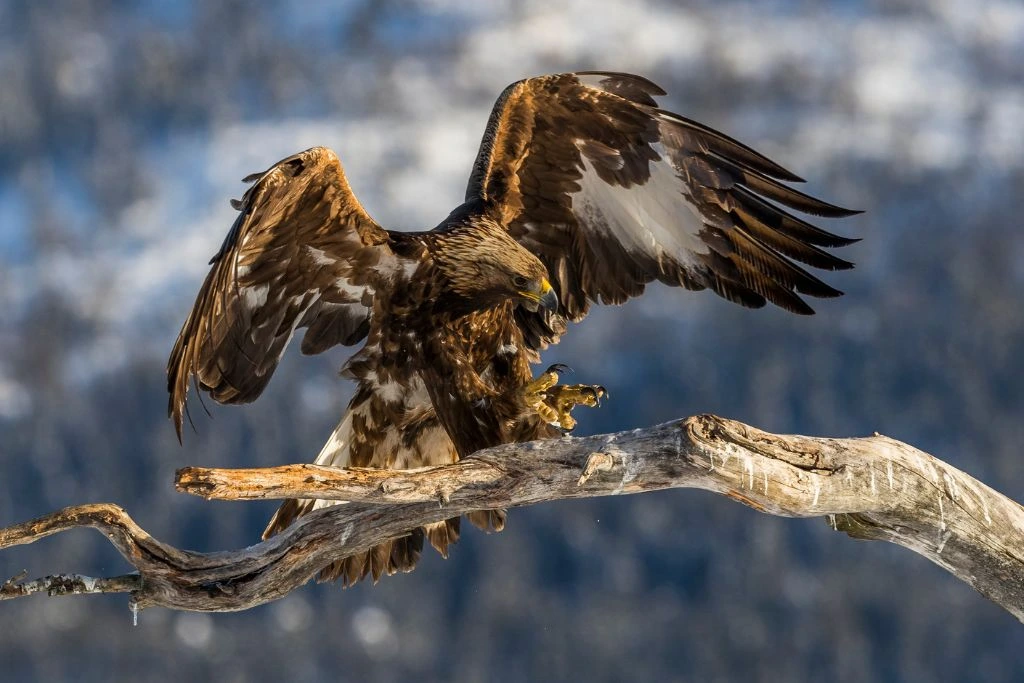Are you ready for a thrilling eagle adventure? Eagles are powerful and unrestrained but have distinct behaviors and adaptations that set them apart from other birds.
They have the keenest eyesight in the avian kingdom, allowing them to see prey from great heights. Prepare to be amazed as we reveal some of these gorgeous birds’ most unique and lesser-known traits. After reading these fascinating facts, you’ll admire eagles whether you’re a birdwatcher or just curious about nature.
All About Eagles: Interesting Facts About Eagles

The eagle family (Accipitridae) includes some genuinely spectacular species. Sharp beaks, powerful talons, and huge wingspans distinguish them. Birds of prey, like eagles, hunt and eat other animals. Known for their importance in avian diversification, these fantastic species are found worldwide except in Antarctica.
Eagles come in various species, each with their unique characteristics. Size, habitat, and behavior classify them. Eagles are also known for their exceptional eyesight and hunting skills, allowing them to identify games from above.
Exploring 19 Fun Facts About Eagles
Eagles are amazing birds, and the bald and golden eagles are famous. From their wingspan to their hunting skills, prepare to explore these gorgeous birds and learn amazing facts about them!
Majestic Birds of the Sky
Eagles are the most beautiful birds in the sky and one of the most enormous birds in the world. Their huge wingspan makes them stand out from other birds. Some of their wings can be up to 8 feet long.
They’re not only big but also pretty heavy. Depending on the eagle type, they can weigh anywhere from 5 to 15 pounds.
They can fly high above the ground with ease and power because of their size and wingspan.
Apex Predators
Eagles are dominant predators in their habitats. They dominate the skies with their incredible hunting techniques. Because of their excellent vision, they can spot their prey from great heights. After spotting a victim, they descend quickly and precisely to grab it with their formidable talons.
Their role in the food chain is crucial to ecology. Predation by eagles helps keep populations of fish, rodents, and even other birds in check. This prevents certain animals from becoming too numerous and damaging their ecosystems. They can hunt well but must also watch out for larger birds and mammals.
Eagles Around the World
There are numerous eagle species, each with their unique characteristics and range. Bald eagles are connected with the U.S. Their white head and tail feathers distinguish the bald eagle, which feeds on fish near lakes and rivers.
Central and South American rainforests are home to the exciting harpy eagle. Black and white feathered, these eagles are among the largest and most powerful. They prey on monkeys and sloths in trees.
Eagles have diverse regional distributions, with species adapted to various climates and landscapes. You’ll likely see one of these beautiful birds in the wild, whether in North America, Africa, Asia, or Australia.
Incredible Sight Range
The incredible sight range of eagles is a game-changer in their world. With eyes that can see far, they have an advantage when hunting and monitoring their territory. They can identify their prey from a mile away! This long-range vision allows them to swoop down accurately to catch their meal.
Eagles hunt by scanning the landscape for movement or water, signaling prey. Their vision lets them see rabbits and fish that we can’t from such heights. They have better ideas than other birds of prey, which helps them survive and dominate the environment.
Power of U.V. Detection
Eagles possess an incredible ability to see in ultraviolet (UV) light. This U.V. vision gives them a unique advantage in spotting prey and navigating their environment. U.V. reflections from animal urine tracks shine naturally, allowing eagles to detect them.
This skill helps them notice small changes in their surroundings, find possible dangers, and, most importantly, find food. Compared to invertebrates and reptiles with U.V. vision, they are top of the food chain.
Size Extremes
Eagles range in size from small to enormous. The little eagle is one of the smallest of its species. Native to Australia, these eagles have a 1.2-meter wingspan. Small mammals and birds are their main diet, typically flying above woodlands.
On the other hand, the harpy eagle is one of the world’s largest and mightiest. Central and South American jungles house harpy eagles. Their wingspan can reach 2.2 meters (about 7 feet), and they hunt monkeys and sloths.
The size differences among eagle species are influenced by their habitats and diets. The lesser eagles eat smaller animals in open places, whereas the larger ones pursue larger species in deep forests.
Lifelong Partners
Eagles are known for their extraordinary commitment to their life partners. A relationship formed by hypnotic mating rituals, trust, and collaboration. They perform stunning flying displays during courting in late winter or early spring.
Once a pair of eagles forms a monogamous relationship, it usually lasts for life. They work together to raise their young and protect their area outside the mating season. This cooperation helps them survive in the wild by sharing parenting and hunting duties.
Nesting Habits

Eagles are diligent nest builders, carefully choosing nesting locations and materials. They favor areas above the ground, typically perched in tall trees or cliffsides. The desire for lofty nesting places protects their young from ground-based predators.
Their nests are challenging to build, starting with gathering branches, twigs, and moss. These materials are skillfully weaved into a large structure that can weigh hundreds of pounds and be several feet wide. They build and repair nests annually, often in one place for generations.
Aerial Speedsters
Eagles are genuine aerial speedsters, capable of reaching impressive velocities in flight. Their astonishing speed is due to an effective combination of traits that make them effective hunters and predators. To attain such high rates, eagles use their large, mighty wings and streamlined bodies.
Their wings provide the necessary lift to soar gracefully through the sky. When hunting or pursuing prey, their mighty breasts fuel their rapid wing strokes.
High-Flying Birds

Eagles are often seen soaring at astonishing altitudes, A behavior with essential purposes. Firstly, flying at high altitudes allows them to conserve energy. They use thermal warm air updrafts to glide freely without any effort.
To support their high-altitude flights, eagles have developed remarkable physiological adaptations. They breathe oxygen from thin air at high altitudes and have strong hearts to circulate oxygenated blood. These characteristics help them survive and thrive thousands of feet above the ground.
Rapid Growth
Eagle chicks, known as eaglets, undergo an awe-inspiring journey from hatching to taking their first flight. They begin life as helpless hatchlings, entirely dependent on their parents for food, warmth, and protection. As the weeks pass, eaglets undergo rapid growth, developing their feathers and steadily increasing in size.
Eaglets love food, especially freshly caught prey, and their parents work hard to feed them with a regular supply. This substantial nourishment fuels their growth, allowing them to become strong and capable eagles.
Natural Parenting
Eagle parents are exemplary in their nurturing behaviors, dispelling common myths about their parenting techniques. They exhibit dedication when incubating their eggs, taking turns keeping them warm and safe. After hatching, both parents actively participate in feeding and protecting their young.
A significant aspect of eagle parenting is the passing on crucial survival skills to their offspring. They teach their young how to hunt effectively, utilizing their keen instincts and remarkable hunting abilities.
Symbol of Freedom
The bald eagle is an important American icon. It is rooted in national history and ideals. It was officially adopted as the national emblem in 1782, a testament to its representation of freedom and strength.
The American Revolution was a significant event that made the eagle a symbol of liberty and independence.
These days, the bald eagle is a big part of the Great Seal of the United States and the country’s flag. No longer merely a symbol, it inspires and unites Americans by reminding them of what made their nation great.
National Treasure
Philippine eagles are the Philippines’ national bird, symbols of pride and conservation. These magnificent eagles, known for their distinctive crown of feathers, are cultural treasures. They are deeply ingrained in the country’s identity, representing the rich biodiversity of the Philippines.
Efforts to protect the Philippine eagle and its vanishing habitats are of paramount importance. Conservation initiatives aim to preserve this national treasure and ensure its survival for future generations.
Primary Diet
Eagles possess a diverse diet, although their primary prey varies depending on the species. They are adept fishermen and prefer to hunt near water where they can grab fish with their keen talons. Other species may primarily prey on mammals, birds, or even carrion.
Their hunting techniques are equally varied, adapting to the specific demands of their environment and prey. Some eagles employ a strategy of swooping down to snatch prey with precision, while others use patience, waiting for the right moment to strike.
Impressive Lifespan
Due to their well-adapted bodies and efficient hunting skills, eagles live long lives. They can live up to 70 years. This longevity extends to both wild and captive eagles. Due to their role as apex predators, which minimizes adult predation, they live longer.
As eagles age, they do face health challenges. For instance, aging eagles may experience tooth decay and wear on their paws, impacting their ability to hunt and feed. They survive and fly for years due to their tremendous survival instincts and hunting skills.
Conservation Awareness
The calendar marks “Save the Eagles Day” to promote eagle and habitat conservation. This observance reminds us of the critical importance of protecting these magnificent birds and their ecosystems.
The history of this day shows how individuals, organizations, and governments globally protect eagle populations. Eagle conservation successes show that proactive approaches can save these famous birds.
Eagles Communication
Eagles communicate using a rich tapestry of cues that go beyond vocalizations. They share with partners and offspring through a sophisticated blend of sounds, body motions, and feather cues.
Body language plays a significant role in eagle communication. They may express emotions and intentions without speaking by tilting their heads or changing their wing position. Fluffing their feathers, for example, can signal aggression or excitement, while smooth feathers indicate calmness.
Keratin Beaks
Eagle beaks, composed of keratin, are marvels of strength and durability. Keratin, found in hair and nails, gives eagles a powerful tool for hunting, shredding food, and grooming. For example, their talons are fortified with keratin, allowing them to secure their prey effectively.
Compared to other birds, eagles have evolved specialized beaks for hunting and feeding. These keratin-based adaptations are essential to their overall hunting prowess and survival in the wild.
| Fact Number | Fact Description |
| 1 | Eagles have impressive wingspans. |
| 2 | They come in various sizes, from small to giant. |
| 3 | They play a crucial role in ecological balance. |
| 4 | Eagles have extraordinary vision, including UV. |
| 5 | They can spot prey from incredibly far distances. |
| 6 | Eagles build massive nests in elevated locations. |
| 7 | They’re known for their breathtaking aerial displays. |
| 8 | Eagles form lifelong monogamous partnerships. |
| 9 | They exhibit nurturing behaviors toward their young. |
| 10 | Bald eagles are a symbol of freedom in the U.S. |
| 11 | The Philippine eagle is of great cultural significance. |
| 12 | Eagles have diverse diets, including fish and mammals. |
| 13 | They are among the longest-living birds of prey. |
| 14 | “Save the Eagles Day” raises awareness for conservation. |
| 15 | Eagles communicate using sounds and body language. |
| 16 | Their beaks are made of durable keratin. |
| 17 | Eagles are expert aerial speedsters. |
| 18 | They are high-flying birds, often soaring at great altitudes. |
| 19 | Eaglets go through rapid growth stages. |
Final Thoughts
We must conserve eagles by preserving their habitats, not damaging their nests, and supporting conservation initiatives. Doing so will allow future generations to admire these majestic birds, reminding us of the need to safeguard our environment.
It’s crucial to remember the importance of protecting eagles and the places they call home. Eagles are not just magnificent birds but vital to our ecosystems, helping maintain balance and diversity. Eagles’ grace and might in the sky are revered by birdwatchers worldwide, and we must protect them.
FAQs
How Intelligent are Eagles?
Eagles are brilliant birds of prey. They exhibit problem-solving skills, keen hunting tactics, and the ability to adapt to changing environments. Their intelligence is primarily focused on survival and hunting.
What are Eagles Most Known for?
Eagles are recognized for their strong talons, powerful beaks, and excellent hunting eyesight. In many countries, including the U.S., they symbolize soaring flight and national pride.





